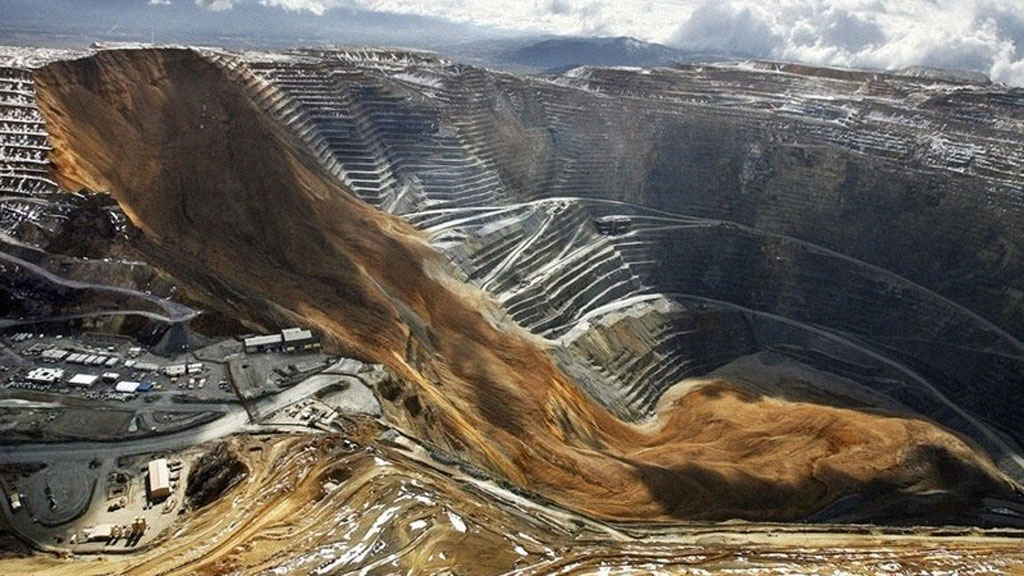
Posted on 04/22/2013 12:52:47 PM PDT by dirtboy

For the past few months I’ve been reporting a big story on the copper industry for Pacific Standard. It takes a broad look at how the global economic boom of the past decade, led by China and India, is pushing copper mining into new regions and new enormities of investment and excavation. (It’ll be out in June.) But a few days ago a very local event shook the copper industry, and I thought it would be neat to look at how a crisis at a single mine can ripple through space and time, ultimately affecting just about everyone around the globe.
Above is a picture, from local news channel KSL, of a massive landslide at Bingham Canyon Mine, about 20 miles southwest of Salt Lake City.
Bingham is an open-pit mine—a gigantic hole in the ground. The landslide, in effect, was the collapse of one of the pit walls. (For scale, the pit is a bit less than three miles wide and a bit more than three-quarters of a mile deep, and as you can see, the collapse stretches halfway across it and all the way from top to bottom.) KSL has more pictures here, and Kennecott Utah Copper, the subsidiary of the mining giant Rio Tinto which runs Bingham Canyon, has a spectacular Flickr set here. Check ’em out.
The landslide went off at about 9:30 in the evening on Wednesday, April 11. It was expected: like most modern mines, Bingham has redundant sensor systems (radar, laser, seismic, GPS) that measure ground movement down to the millimeter and give plenty of warning when a collapse is imminent. The mine was evacuated about 12 hours before the landslide, and nobody was hurt.
(Excerpt) Read more at boingboing.net ...
ping
“...like most modern mines, Bingham has redundant sensor systems (radar, laser, seismic, GPS) that measure ground movement down to the millimeter and give plenty of warning...”
Well, in the U.S., Canada and similar places. China, Indonesia and Algeria probably not so much. If the environmentalists really cared about the environment, worker’s safety, etc. - they would allow more mines in the U.S.
Meanwhile back at Pocupine creek
I bet not many ants live in those mines.
There isn’t much of anything living near those mines.
A classic example of soil fluidization, were that not going into a pit it could have flowed out well over a mile or more. You see the same thing in some powder coating process’s where the material is suspended with air over a fluidized board.
@#$%^!!!! We gotta get this bulldozer running or Grandpa will lose the claim! Meanwhile down the creek, the Dakota Boys are all having withdrawal from the lack of morphine....
Shadow or not, "that pit" is responsible for 17% of US consumption of copper and 1% of total world consumption.
Australian, I believe.
Actually, angle of repose has little to do with establishing highwall angle. It’s more about rock strength and orientation of structure (faults, joints, etc.), and changing slope angle just a degree one way or the other can make a difference of millions of tons of stripping.
A slope engineer once told me that there are only two rules for determining slope angle. If it fails, it was too steep, and if it never fails, it wasn’t steep enough.
“The big open pit mines in Michigan are iron mines.”
My experience with open pit mining had to do with conveyor belt manufacturing...customers included Cleveland Clifts Empire Mine in Negaunee, MI and the Mesabi Range in MN - both iron ore operations. Btw, Cleveland Clifts has announced they are shutting down. Also supplied stuff to the Anaconda operations in AZ.
I knew she was a coal miners daughter, I could tell by the slack in her pants.
I actually spent 8 years in Salt Lake City “a long time ago” and could see the mine from where I lived, off in the distance.
Never did actually go on any sort of tour, and have no idea where they put the overburden ... but there’s got to be a lot of it.
You are correct that the general term angle-of-repose is more suited to earthen slope issues and the analysis is much more complex analysis of the entire mountainside.
I am not in the design field, but I do get to build what those on that side of the fence draw and plan and I wanted to make clear that this was not some sort of sluff of tailings — a cosmetic failure almost — instead the whole side of pit has failed.
Disclaimer: Opinions posted on Free Republic are those of the individual posters and do not necessarily represent the opinion of Free Republic or its management. All materials posted herein are protected by copyright law and the exemption for fair use of copyrighted works.